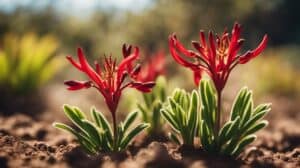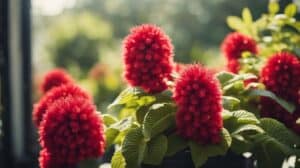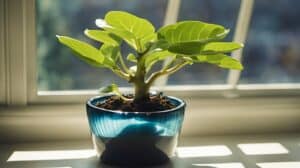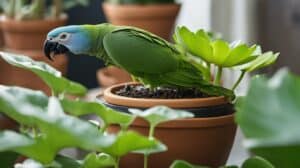Venus flytraps are one of the most fascinating and unique plants in the world.
These carnivorous plants are native to the wetlands of the southeastern United States and have been a popular addition to many plant collections for years.
While they may seem difficult to grow, propagating Venus flytraps is actually quite easy once you know the secrets.

One of the most important things to know about Venus flytrap propagation is that these plants require a specific type of soil.
They thrive in a mixture of peat moss and sand, which provides the right nutrients and drainage for their unique needs.
It’s also important to keep the soil moist but not too wet, as Venus flytraps are sensitive to overwatering.
Another key factor in successful Venus flytrap propagation is providing the right amount of light.
These plants require bright, indirect sunlight to grow and thrive.
In fact, they can even be grown indoors as long as they are placed near a window or under a grow light.
With the right soil and lighting conditions, anyone can grow their own Venus flytrap collection and enjoy these fascinating plants for years to come.
Understanding Venus Flytrap Biology
Anatomy of Venus Flytrap
The Venus Flytrap is a carnivorous plant that has adapted to live in nutrient-poor soil by trapping and digesting insects.
It has a unique structure that consists of a rosette of leaves, each with a petiole (stalk) and a blade (trap).
The blade is divided into two lobes that are hinged at the midrib.
Each lobe has three trigger hairs that, when stimulated, cause the lobes to snap shut, trapping the prey inside.
The Venus Flytrap also has a specialized digestive system that allows it to break down the insect’s proteins and extract the nutrients it needs.
The digestive process takes several days, after which the trap reopens to release any remaining exoskeleton.
Growth Cycle and Dormancy
The Venus Flytrap has a distinct growth cycle that is influenced by seasonal changes.
It typically grows during the spring and summer months, producing new leaves and traps. In the fall, the plant begins to slow down and prepare for dormancy.
During this time, the leaves and traps begin to die back, and the plant enters a period of rest.
Dormancy is an essential part of the Venus Flytrap’s life cycle, as it allows the plant to conserve energy and prepare for the next growing season.
During this time, the plant should be kept in a cool, dark place with reduced watering.
This period usually lasts from November to February, after which the plant will begin to produce new growth.
Understanding the biology of the Venus Flytrap is crucial for successful propagation.
By providing the right growing conditions and care, you can cultivate a thriving collection of these fascinating plants.
Propagation Techniques

Growing Venus flytraps from seeds or cuttings is a rewarding experience.
By using proper propagation techniques, you can multiply your carnivorous collection and enjoy the beauty of these fascinating plants.
Here are three propagation methods that you can use to grow your Venus flytraps.
Seed Propagation
Growing Venus flytraps from seeds is a fun and easy way to expand your collection. To start, sow the seeds in a mix of peat moss and sand.
Keep the soil moist and warm, and provide bright light. Germination usually takes 2-4 weeks.
Once the seedlings are large enough, transplant them into individual pots.
Division Propagation
Division propagation is another way to propagate Venus flytraps.
This method involves dividing the rhizome of an established plant into several pieces, each with its own roots and leaves.
To do this, gently remove the plant from its pot and separate the rhizome into sections. Plant each section in its own pot with fresh soil.
Leaf Cuttings Method
The leaf cuttings method is another way to propagate Venus flytraps.
This method involves taking a leaf from an established plant and cutting it into several pieces.
Each piece should have a portion of the leaf blade and a small section of the petiole. Plant each cutting in a pot with a mix of peat moss and sand.
Keep the soil moist and warm, and provide bright light. In a few weeks, new plantlets will emerge from the base of the cuttings.
By using these propagation techniques, you can easily grow your Venus flytrap collection.
Remember to be patient and provide your plants with the right growing conditions, and you’ll soon have a thriving carnivorous garden.
Caring for Young Venus Flytraps

Growing Venus Flytraps from seeds or small plantlets can be a rewarding experience, but it requires careful attention to their unique needs.
Optimal Soil Conditions
Young Venus Flytraps thrive in a well-draining soil mix that is low in nutrients. A mix of peat moss and perlite or sand is ideal.
It is important to avoid using regular potting soil, which can be too rich in nutrients and harm the delicate roots of the plant.
Watering and Humidity Requirements
Venus Flytraps need to be kept moist, but not waterlogged.
It is important to water them with distilled or rainwater, as tap water can contain minerals that are harmful to the plant.
The soil should be kept evenly moist, but not soggy.
To increase humidity, the plant can be placed in a terrarium or covered with a clear plastic bag with air holes.
Light and Temperature Needs
Young Venus Flytraps require bright, indirect light to grow properly.
They should be placed in a south-facing window or under a grow light for 12-14 hours a day.
The ideal temperature range for Venus Flytraps is between 70-85°F during the day and 50-60°F at night.
They can tolerate higher temperatures for short periods, but prolonged exposure to temperatures above 90°F can be harmful to the plant.
By providing the right growing conditions, young Venus Flytraps can grow into healthy and thriving plants.
With patience and attention, they can become a unique and fascinating addition to any carnivorous plant collection.
Troubleshooting Common Issues

Pest and Disease Management
Despite their carnivorous nature, Venus Flytraps are still susceptible to pests and diseases.
Here are some common issues you may encounter and how to manage them:
- Aphids: These small, soft-bodied insects can be controlled with an insecticidal soap or neem oil.
Be sure to spray the entire plant, including the undersides of leaves, and repeat the treatment every 7-10 days until the infestation is gone.
- Spider Mites: These tiny arachnids can cause yellowing and stippling of leaves.
They can be controlled with a miticide, but prevention is key.
Keep the humidity around your plants high and avoid over-fertilizing, as spider mites thrive in dry, nutrient-rich environments.
- Fungal Diseases: If you notice black spots or rot on your Venus Flytrap, it may be suffering from a fungal disease.
Remove any affected leaves and avoid getting water on the plant’s foliage, as this can encourage fungal growth.
You can also apply a fungicide to the soil to prevent the disease from spreading.
Nutrient Deficiencies and Feeding
Venus Flytraps derive most of their nutrients from insects, but they still require some additional care to thrive.
Here are some common issues related to nutrient deficiencies and feeding:
- Yellowing Leaves: If your Venus Flytrap’s leaves are turning yellow, it may be suffering from a lack of nutrients.
Make sure you are feeding it regularly with live insects or a high-quality carnivorous plant fertilizer.
- Overfeeding: While Venus Flytraps do require regular feeding, overfeeding can lead to root rot and other issues.
Stick to feeding your plant once every 1-2 weeks, and avoid feeding it more than one insect at a time.
- Fertilizer Burn: If you are using a fertilizer on your Venus Flytrap, be sure to dilute it to half strength or less.
Over-fertilizing can cause fertilizer burn, which can lead to leaf burn and other issues.
By keeping an eye out for these common issues and taking steps to prevent and manage them, you can ensure that your Venus Flytrap collection stays healthy and thriving.
Frequently Asked Questions

How can I successfully propagate a Venus flytrap from seed?
Propagating Venus flytrap from seeds is a great way to expand your carnivorous collection. The best time to sow the seeds is in the spring season.
To propagate a Venus flytrap from seed, you will need to create a soil mixture of sphagnum moss and perlite.
You can then sprinkle the seeds on top of the soil and cover them with a thin layer of sphagnum moss.
Keep the soil moist and warm, and the seeds should germinate in about 2-4 weeks.
What are the ideal soil conditions for Venus flytrap growth?
Venus flytraps require a soil mixture that is free-draining and nutrient-poor.
A good soil mixture for Venus flytrap growth is one that is made up of sphagnum moss and perlite.
The soil should be kept moist, but not waterlogged, as Venus flytraps are sensitive to overwatering.
What is the best way to care for a Venus flytrap during the winter months?
During the winter months, Venus flytraps go into a dormant period.
It is important to reduce watering during this time, as the plant’s growth slows down.
The plant should be kept in a cool location with temperatures between 40-50°F.
If you are growing your Venus flytrap indoors, you can move it to a cooler room or place it near a window.
What should I feed my Venus flytrap, especially when kept indoors?
Venus flytraps are carnivorous plants that feed on insects. When kept indoors, you can feed your Venus flytrap small insects such as fruit flies or gnats.
It is important not to overfeed your plant, as this can lead to root rot.
You can also use a diluted fertilizer solution to supplement your plant’s diet.
How do I ensure my Venus flytrap flourishes in its growing environment?
To ensure your Venus flytrap flourishes, it is important to provide it with the right growing conditions.
This includes a soil mixture that is free-draining and nutrient-poor, adequate sunlight, and proper watering.
Venus flytraps require at least 4-6 hours of direct sunlight per day, so placing them near a window or under grow lights can help them thrive.
What are the stages of the Venus flytrap life cycle?
The Venus flytrap life cycle consists of three stages: the vegetative stage, the flowering stage, and the seed production stage.
During the vegetative stage, the plant produces leaves and grows in size. In the flowering stage, the plant produces a tall stalk with white flowers.
In the seed production stage, the plant produces seeds that can be used to propagate new Venus flytraps.













